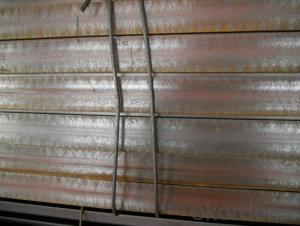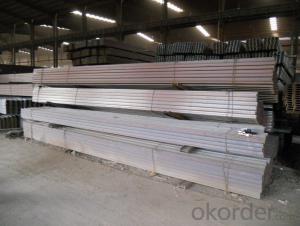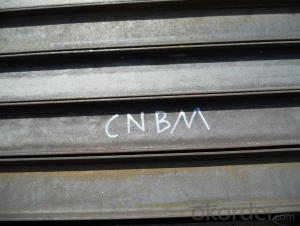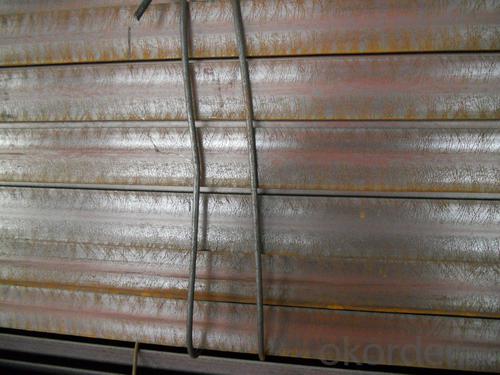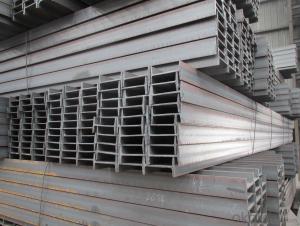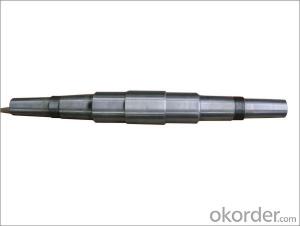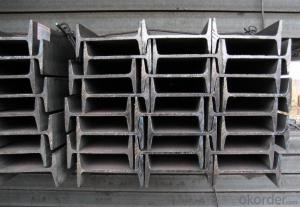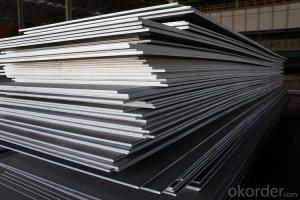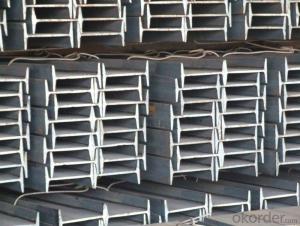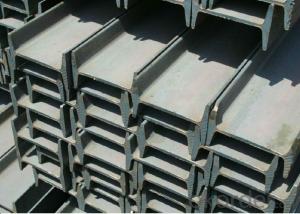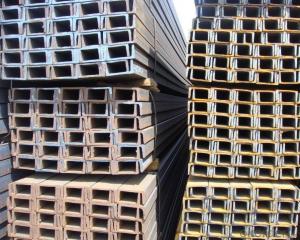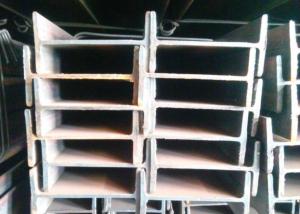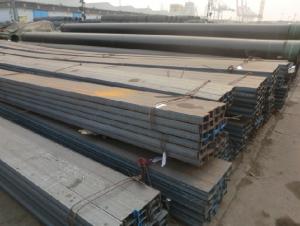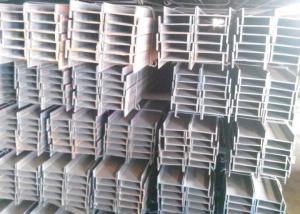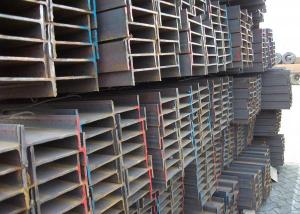Hot rolled stainless steel I-Beam for construction
- Loading Port:
- Tianjin
- Payment Terms:
- TT or LC
- Min Order Qty:
- 25 m.t.
- Supply Capability:
- 100000 m.t./month
OKorder Service Pledge
OKorder Financial Service
You Might Also Like
Hot rolled stainless steel I-Beam for constructionProduct Description:
OKorder is offering Hot rolled stainless steel I-Beam for construction at great prices with worldwide shipping. Our supplier is a world-class manufacturer of steel, with our products utilized the world over. OKorder annually supplies products to European, North American and Asian markets. We provide quotations within 24 hours of receiving an inquiry and guarantee competitive prices.
Product Applications:
Hot rolled stainless steel I-Beam are ideal for structural applications and are widely used in the construction of buildings and bridges, and the manufacturing, petrochemical, and transportation industries.
Product Advantages:
OKorder's Steel I-Beam for construction are durable, strong, and resist corrosion.
Main Product Features:
· Premium quality
· Prompt delivery & seaworthy packing (30 days after receiving deposit)
· Corrosion resistance
· Can be recycled and reused
· Mill test certification
· Professional Service
· Competitive pricing
Product Specifications:
Applications of IPEAA Beam
1. structure construction and electronic tower building construction
2. bridge, trestle, autos, brackets, machinery
3.It is widely used in various building structures and engineering structures such as roof beams, bridges, transmission towers, hoisting machinery and transport machinery, ships, industrial furnaces, reaction tower, container frame and warehouse etc.
Package & Delivery Terms of IPEAA Beam
1. Packing: it is nude packed in bundles by steel wire rod
2. Bundle weight: not more than 3.5MT for bulk vessel; less than 3 MT for container load
3. Marks:
Color marking: There will be color marking on both end of the bundle for the cargo delivered by bulk vessel. That makes it easily to distinguish at the destination port.
Tag mark: there will be tag mark tied up on the bundles. The information usually including supplier logo and name, product name, made in China, shipping marks and other information request by the customer.
If loading by container the marking is not needed, but we will prepare it as customer request.
4. All the IPEAA Beams will be delivered to the port of Tianjin within 45 days after receiving the Original L/C at sight or the advance payment by T/T.
5. Transportation: the goods are delivered by truck from mill to loading port, the maximum quantity can be loaded is around 40MTs by each truck. If the order quantity cannot reach the full truck loaded, the transportation cost per ton will be little higher than full load.
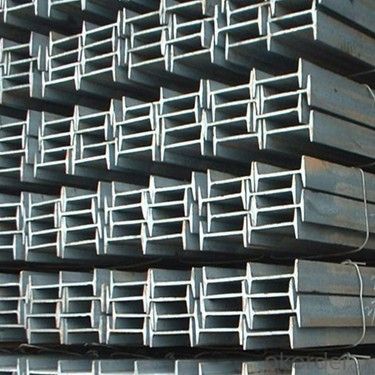
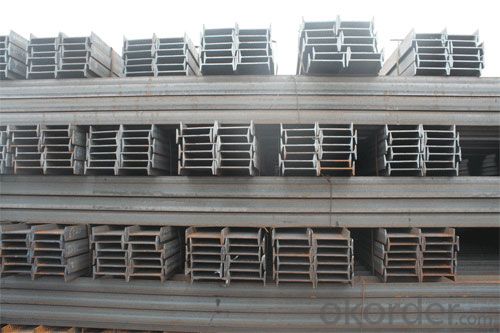
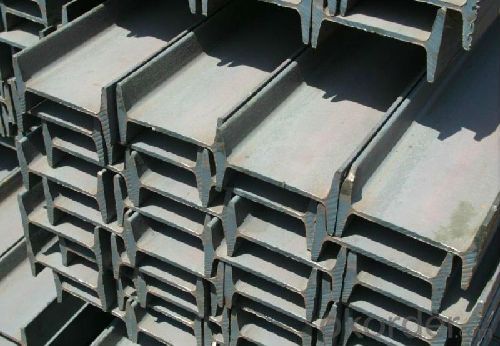
FAQ:
Q1: What makes stainless steel stainless?
A1: Stainless steel must contain at least 10.5 % chromium. It is this element that reacts with the oxygen in the air to form a complex chrome-oxide surface layer that is invisible but strong enough to prevent further oxygen from "staining" (rusting) the surface. Higher levels of chromium and the addition of other alloying elements such as nickel and molybdenum enhance this surface layer and improve the corrosion resistance of the stainless material.
Q2: Can stainless steel rust?
A2: Stainless does not "rust" as you think of regular steel rusting with a red oxide on the surface that flakes off. If you see red rust it is probably due to some iron particles that have contaminated the surface of the stainless steel and it is these iron particles that are rusting. Look at the source of the rusting and see if you can remove it from the surface.
- Q: How do steel I-beams perform in terms of long-term deflection?
- Steel I-beams are known for their excellent performance in terms of long-term deflection. Due to their structural design and material properties, steel I-beams have a high resistance to deflection over time. The unique shape of the I-beam, with its flanges and web, allows it to distribute loads evenly and efficiently, minimizing the effects of long-term deflection. The flanges of the I-beam are designed to resist bending moments, while the web resists shear forces. This combination of resistance against bending and shear ensures that the beam maintains its shape and stability over an extended period. Furthermore, steel, as a material, exhibits high strength and stiffness, which helps to limit long-term deflection. It has a low creep rate, meaning it experiences minimal deformation over time under a constant load. This characteristic is crucial in maintaining the structural integrity of the I-beam, as it prevents excessive sagging or bending. Additionally, steel I-beams are commonly fabricated using hot-rolled steel, which undergoes a controlled cooling process to enhance its strength and reduce internal stresses. This process further improves the long-term deflection performance of the I-beam. While steel I-beams perform exceptionally well in terms of long-term deflection, it is important to note that the specific performance can vary depending on factors such as the design, size, and loading conditions of the beam. Proper engineering and consideration of these factors are essential to ensure optimal long-term deflection performance.
- Q: How do steel I-beams handle extreme temperatures?
- Steel I-beams are known for their excellent strength and durability, making them a popular choice for structural support in various applications. When it comes to extreme temperatures, steel I-beams generally perform well due to their unique properties. Steel has a high melting point, typically around 1370 degrees Celsius (2500 degrees Fahrenheit). This means that in most cases, steel I-beams can withstand extreme temperatures without experiencing any significant structural damage. However, it's important to note that steel does expand and contract with temperature variations, which can affect its overall performance. In high-temperature environments, such as during a fire, steel I-beams may lose some of their strength due to thermal expansion. As the temperature rises, the steel expands, which can lead to distortions and buckling. However, steel's inherent strength allows it to retain its load-bearing capacity even when it is heated. On the other hand, in extremely cold temperatures, steel tends to become more brittle and prone to fracture. This is due to the reduction in ductility, which is the ability of a material to deform without breaking. In these conditions, steel I-beams may become more susceptible to cracking, especially if subjected to sudden impact or excessive loads. To mitigate the effects of extreme temperatures, engineers and designers often use various techniques. These can include implementing fire protection measures, such as fire-resistant coatings or insulation, to delay the onset of thermal expansion and maintain the structural integrity of the steel I-beams during a fire. Additionally, careful consideration is given to the material selection and design of the I-beams to ensure they can withstand anticipated temperature variations. In summary, steel I-beams are generally well-suited to handle extreme temperatures. They have a high melting point and retain their load-bearing capacity even when exposed to high temperatures. However, caution must be exercised in extreme cold temperatures to prevent potential brittleness and cracking. Proper design, material selection, and fire protection measures can help ensure the performance and longevity of steel I-beams in extreme temperature environments.
- Q: Can steel I-beams be used for bridges?
- Yes, steel I-beams can be used for bridges. Steel I-beams are commonly used in bridge construction due to their high strength-to-weight ratio, durability, and versatility. They provide excellent structural support and can withstand heavy loads, making them ideal for spanning long distances. Additionally, steel I-beams can be customized to meet the specific requirements of a bridge project, such as varying lengths and sizes. Their use in bridge construction has been proven to be reliable and cost-effective, making steel I-beams a popular choice for bridge engineers and builders.
- Q: Are there any alternatives to steel I-beams?
- Yes, there are several alternatives to steel I-beams. Some popular alternatives include engineered wood beams, such as laminated veneer lumber (LVL) and glued laminated timber (glulam), which provide similar strength and load-bearing capacity as steel. Another alternative is reinforced concrete beams, which offer high durability and can be customized to fit specific design requirements. Additionally, composite beams made of materials like fiberglass or carbon fiber reinforced polymers (FRP) are gaining popularity due to their lightweight nature and corrosion resistance.
- Q: Can steel I-beams be used in the construction of stadiums and arenas?
- Certainly, stadiums and arenas can indeed utilize steel I-beams in their construction. In actuality, these beams are extensively employed in the construction field due to their remarkable strength, durability, and versatility. With their exceptional structural integrity, steel I-beams possess the ability to bear heavy loads and cover large spans, which are indispensable prerequisites in the context of stadiums and arenas. Moreover, they offer excellent resistance against bending and deflection, thereby guaranteeing the stability and safety of the structures. Furthermore, steel I-beams can be easily manipulated and molded to conform to the specific design specifications of the stadium or arena, thus allowing for enhanced flexibility in terms of design and construction. Ultimately, due to their superior strength, durability, and capacity to endure the rigorous structural demands of such extensive projects, steel I-beams are unequivocally the preferred choice in the construction of stadiums and arenas.
- Q: Are steel I-beams resistant to electromagnetic radiation?
- No, steel I-beams are not inherently resistant to electromagnetic radiation. Electromagnetic radiation encompasses a wide range of frequencies, including radio waves, microwaves, infrared, visible light, ultraviolet, X-rays, and gamma rays. Steel, being a good conductor of electricity, can actually amplify certain types of electromagnetic radiation, such as radio waves and microwaves. However, steel I-beams can provide some level of shielding against certain frequencies of electromagnetic radiation, particularly in the lower frequency range. For example, they can offer some protection against radio waves and microwaves, but their effectiveness decreases as the frequency increases. Steel I-beams are generally not effective at blocking higher frequency radiation such as X-rays and gamma rays. To increase the resistance to electromagnetic radiation, additional measures can be taken, such as adding electromagnetic shielding materials or coatings to the steel beams. These materials can help to attenuate or redirect the electromagnetic waves, reducing their penetration through the steel I-beams. It is important to note that the level of electromagnetic radiation resistance required depends on the specific application and the desired level of protection. Therefore, it is advisable to consult with experts in electromagnetic radiation shielding and consider specific requirements before finalizing the use of steel I-beams in situations where electromagnetic radiation protection is a concern.
- Q: Can steel I-beams be used in parking structures?
- Parking structures can indeed utilize steel I-beams. These beams are frequently employed in the construction of parking structures owing to their robustness, longevity, and capacity to bear substantial loads. They offer structural steadiness and can cover large spans, thereby facilitating spacious and adaptable parking arrangements. Furthermore, steel I-beams exhibit superior fire resistance, rendering them a secure alternative for parking structures. Their adaptability and cost-efficiency have made steel I-beams a favored selection for architects and engineers involved in designing parking structures.
- Q: What are the different fabrication methods for steel I-beams?
- Steel I-beams can be fabricated using various methods, each with its own benefits and applications. 1. The most commonly employed technique is hot rolling. This involves heating a sizable steel billet above its recrystallization temperature and then passing it through a series of rollers to shape it into the desired I-beam profile. Hot rolling ensures excellent structural integrity and consistent dimensions and mechanical properties. 2. Another method involves welding or assembling individual steel plates or sections to create the I-beam shape. This approach is often used for specialized or custom applications where the dimensions or properties of the I-beam need to be tailored. Welding can be accomplished using various techniques, such as submerged arc welding or gas metal arc welding, depending on the specific requirements. 3. Cold rolling is another technique utilized to shape steel strips or plates into the I-beam profile. Unlike hot rolling, this process is carried out at room temperature. Cold rolling is typically employed for smaller-sized I-beams or applications where precise dimensions and surface finish are crucial. It is also commonly used for stainless steel I-beams. 4. Extrusion is a process that can create intricate cross-sectional shapes with a continuous length. For steel I-beams, a heated billet is forced through a die to form the desired I-beam shape. Extrusion is frequently utilized to manufacture lightweight or specialized I-beams with unique profiles. Each fabrication method has distinct advantages and considerations, such as cost, production speed, size limitations, and the ability to meet specific design requirements. The choice of fabrication method depends on factors such as the desired I-beam size, properties, and application.
- Q: What are the common finishes or coatings applied to steel I-beams?
- Steel I-beams can be enhanced in durability, aesthetic appeal, and corrosion resistance through the application of various finishes or coatings. Some commonly used options include: 1. Hot-dip galvanizing, which involves immersing the steel I-beams in molten zinc to create a protective layer that prevents rust and corrosion. This method is ideal for outdoor or high-moisture environments. 2. Powder coating, where a dry powder is applied to the steel I-beams and then cured under heat to form a durable finish. This process allows for a wide range of colors and textures, providing both protection against corrosion and aesthetic appeal. 3. Epoxy paint, which offers excellent adhesion and resistance to chemicals, making it suitable for harsh environments. Typically applied in multiple coats, epoxy paints create a tough barrier against corrosion. 4. Metallic coatings, such as aluminum or zinc, can be applied to steel I-beams using methods like electroplating or thermal spraying. These coatings provide a sacrificial layer that corrodes before the steel, thus extending the lifespan of the I-beams. 5. Primer/topcoat systems provide additional protection by coating the steel I-beams with a primer to enhance adhesion, followed by a topcoat for aesthetic appeal and resistance to corrosion. This type of system is commonly used in architectural or decorative applications. It is important to consider the intended use and environmental conditions when choosing a finish or coating for steel I-beams. Seeking advice from professionals or manufacturers can assist in determining the most suitable option for specific requirements.
- Q: Can steel I-beams be used in residential remodeling or addition projects?
- Yes, steel I-beams can be used in residential remodeling or addition projects. They are commonly used to provide structural support in various aspects of residential construction, such as for creating open floor plans, supporting heavy loads, or spanning large distances. Steel I-beams offer strength, durability, and versatility, making them a popular choice in residential construction.
Send your message to us
Hot rolled stainless steel I-Beam for construction
- Loading Port:
- Tianjin
- Payment Terms:
- TT or LC
- Min Order Qty:
- 25 m.t.
- Supply Capability:
- 100000 m.t./month
OKorder Service Pledge
OKorder Financial Service
Similar products
Hot products
Hot Searches
Related keywords
